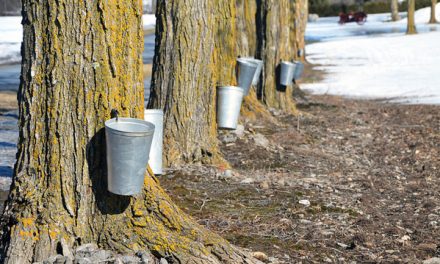The swine industry is doing all that it can to ensure there are no cross infections between humans and pigs and pigs and humans. At the same time the industry is working on ways to mitigate any kind of swine flu outbreak. Mark Slack photo
by Tricia Surette
AgriNews Contributor
TWEED – News of a potential new virus found in Chinese swine herds was published in the American publication “Proceedings of the National Academy of Sciences (PNAS) on June 29.”
Scientific research shows the virus has the potential of moving into humans.
The news hit the media recently after a study completed by a group of Chinese scientists’ mainstream media outlets used words like “human pandemic potential” and “possible new ‘pandemic virus’” to add to the already high anxiety levels that humans are currently coping with due to Covid-19, essentially sensationalizing what is largely an already known issue in the swine and science community.
“It’s nothing that we didn’t already know,” said Dr. Christa Arsenault DVM, lead veterinarian at Ontario Ministry of Agriculture, Food, and Rural Affairs (OMAFRA). “There’s no really new information there; there are veterinarians that devote their whole careers to studying these changes that happen within influenza A viruses.”
Swine is considered a mixing vessel for viruses according to Dr. Paul Sundberg, executive director of the Swine Health Information Center based in Iowa.
“You have to have a certain lock on a cell in order for influenza to stick a key into it and open that cell up so it can infect,” said Sundberg. “What we know is that pigs have the unique ability to have both human and pig locks in their cells, so a pig virus could infect a pig as well as a human virus could infect a pig.”
Sometimes multiple viruses connect within the same cell and this causes a recombining of the viral RNA, sometimes resulting in a more virulent strain of influenza that has the chance if passed to humans, to become a serious health crisis.
The key to this issue isn’t that these viruses exist or that viral recombining is happening, because they do exist and they do recombine. What is important is what the swine industry is doing to prevent the viral recombining and cross-infections between species, and whether the industry is equipped to handle any outbreaks both on a local scale and a worldwide scale.
Since 2014, the swine industry has been coping with Porcine Epidemic Diarrhea (PED), a virulent form of diarrhea passed easily among herds and pigs through various vectors, including boots and equipment. It is not dangerous to humans but PED was a learning curve for the industry. The result is the industry is better prepared to prevent a future viral outbreak.
Mark Slack, a swine farmer in Tweed, Ont., with 2,400 finishing gilts and 600 nursery weaners, has extensive bio-security in place to keep both humans and his swine healthy.
“Nothing from the outside comes inside,” said Slack, “unless it’s cleaned and sanitized.”
Visitors to the farm have to be cleared in advance, they cannot have been around any other hogs in the previous 24 hours, and when they arrive on site, they go through a rigorous cleaning before entering the barn. The cleaning involves a complete strip down, a shower, new clothes to wear into the barn and the procedure is then reversed upon leaving. All tradespeople who enter the barn have to sanitize their equipment and all delivery trucks that enter the property have to be certified sanitized. Dead stock is handled by a composter on site.
Every swine farmer in Ontario adheres to some level of bio-security advised Arsenault, and each farmer establishes their own system based on parameters set out by the ministry and in consultation with their own veterinarians. Each province has protocols in place, though there might be small variations, they are very similar.
An additional level of bio-security is the regular testing of swine herds. In conjunction with their vet, a farmer will have samples of blood, tissues, feces and/or mucus taken quarterly, semi-annually and annually and sent to labs for testing. This regular testing improves the chances of early detection.
“Laboratories in Ontario are obligated through two pieces of legislation to report new or novel influenza subtypes to both OMAFRA,” said Arsenault, “as well as to the Ministry of Health and Long-Term Care. Those legislative requirements are in place so we have immediate notification if there’s something novel that appears with influenza.”
Dr. Jaspinder Komal, chief veterinarian officer for the Canadian Food Inspection Agency (CFIA), highlighted Canada’s swine production being mainly indoors, with very little contact with
humans, as one of the key differences between Canadian practices and practices in other countries. What little contact occurs between humans and animals is strictly handled through the biosecurity protocols.
“We are working with the industry,” said Komal, “to promote an animal health strategy which is prevention.”
The prevention strategy is based around four pillars: preparedness; enhanced biosecurity; business continuity and communication. These pillars were developed due to African Swine Fever, a swine illness that is also being monitored by the CFIA, but they equally apply to any possible threat that may be detected in the future.
“There’s a risk always,” said Komal, “but the risk is low in Canada.”
Communication between countries, provinces and different levels of government is one of the key pillars that Komal has been working to develop. If something were to turn up anywhere, he has the ability to quickly respond and compartmentalize as needed any outbreak, so that it doesn’t affect the entire swine industry. There are agreements between trading partners that reflect those practices, so that if there was a viral outbreak in a herd in Ontario, it wouldn’t affect the ability of Manitoba’s swine producers to continue exporting.
The communication extends to research as well.
“Sometimes you get clues that something is coming at you,” said Dr. Sundberg. “It’s really important that we have open communication and trading of data between countries because that’s the way we get enough body of information that we can say ‘Uh, oh something is likely to happen so we better keep it from happening.’”
The general consensus between farmers and scientists and the different levels of government is that Ontario and Canada are doing all they can to prevent any possible outbreak but in the very small chance one was to occur, they are also prepared to handle it.
“Prevention, prevention, prevention!” said Komal. “So much easier and more economical to do prevention than to actually eradicate or manage it after the fact.”













